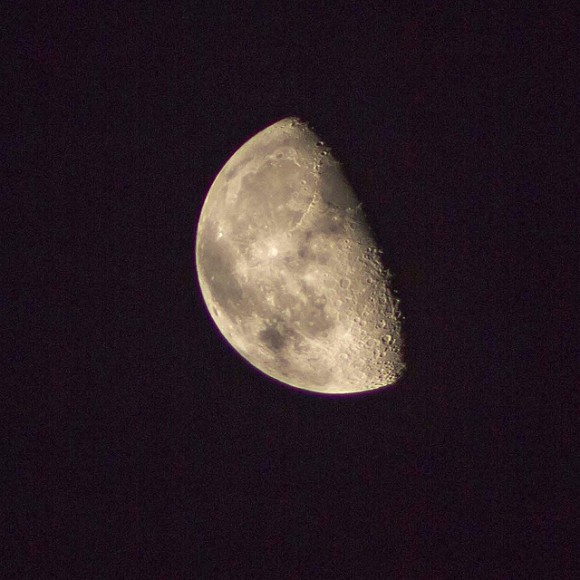Wondering why a new research team says the Earth and the Moon is 60 million years older than previously believed? Well, it’s a gas. It has to do with the proportion of different gas types that have stuck around since the Earth was formed about 4.5 billion years ago.
Since Earth had no solid surface at the time, traditional geology doesn’t really work — there’s no rock layers to examine, for example. So while the geologists caution we’ll likely never know for sure when the Earth came together, a new dating method for the gases show it was earlier than believed, they said.
To back up a step, the leading theory for how the Moon formed is that a Mars-sized object smashed into our planet, created a chain of debris, and over a long time gradually came together and formed the Moon. There’s been a flurry of news on this event in recent days. Different science groups have found evidence of the crash in Earth and Moon materials, and said it could explain why the Moon’s far side is so rugged compared to the near side.
For this study, Guillaume Avice and Bernard Marty (who are both geochemists from the University of Lorraine in Nancy, France) examined xenon gas in quartz found in Australia (previously believed to be 2.7 billion years old) and South Africa (3.4 billion years old).

“Recalibrating dating techniques using the ancient gas allowed them to refine the estimate of when the Earth began to form,” stated the Goldschmidt Geochemistry Conference in Sacramento, California, where this was presented today (June 10). “This allows them to calculate that the Moon-forming impact is around 60 million years (+/- 20 m. y.) older than had been thought.”
This also affects calculations concerning when the Earth’s atmosphere formed. Since the atmosphere could not have stuck around after the big crash, this means that the previous estimate of 100 million years after the solar system’s formation wouldn’t work. So if the Earth and the Moon are 60 million years older, the Earth’s atmosphere formed about 40 million years after the solar system’s formation.
It’ll be interesting to see if other scientists agree with the analysis.
Source: Goldschmidt Geochemistry Conference


The first robust dating I heard of for the Tellus-Theia collision making Earth-Moon was using highly siderophile elements (HSEs) to constrain the evolution of the late accretion. [“Highly siderophile elements in Earth’s mantle as a clock for the Moon-forming impact”, Jacobson et al, Nature 2014] That indeed puts the impact at 95 +/- 32 million years after condensation of the systems’ first solids.
That method stresses these, presumably less precise, isotope dating methods a lot. They exclude the 40 million base date at 97.5 % and the 60 million year 1 sigma limit at 1 sigma.
If the used dating is Xe-I [ http://en.wikipedia.org/wiki/Iodine-129 ; used for meteorite age dating], it is a radiometric clock. The paper says the following on those:
“A late Moon formation has two profound implications.
First, it constrains the dynamical conditions of the disk from which the planets accreted and the physical properties of the disk material. For instance, a late last giant impact implies that most of the mass was in the embryo population rather than the planetesimal population.
Second, reconciling a late Moon-forming event with radiometric chronometers that suggest the opposite result may require challenging fundamental assumptions, such as envisioning a Moon-forming event that did not reset all clocks simultaneously and left significant parts of the mantle non-equilibrated with the core. That may argue in favor of some of the new scenarios proposed for the Moon-forming collision31,32, which distribute impact energy heterogenously and may leave a significant portion of the Earth’s mantle relatively undisturbed.”
I am no expert.
But I have previously argued elsewhere that one of those links, the oxygen isotope difference found in Moon rocks, which makes Theia enstatite like may suggest an “E ring” embryo origin. (Specialist Bill Bottke thinks there was a now disappeared inner (IIRC) enstatite ring that now forms the Hungarians.) Having two about similarly massed bodies (Mars, Theia) formed at about the same place at about the same time is not a huge reach.
I hadn’t made the connection until this forced me to reread the Jacobson et al paper. Now I will argue that another of those links, the observed mantle heterogenities of Earth, indeed seem to make radiometric dating methods problematic as suggested. And that the 100 Ma result, as being robust against such problems, is the more likely.
““But we believe that the impact energy was not evenly distributed throughout the ancient Earth. This means that a major part of the impacted hemisphere would probably have been completely vaporized, but the opposite hemisphere would have been partly shielded, and would not have undergone complete melting.”
The team said that the impact did not completely stir the mantle, which would explain why the ratio of isotopes of helium and nitrogen inside the shallow part of the mantle is much higher than the deep mantle.”
[A casino bar. A scientist rest his elbow against the disk. While eyeing the crowd, he calmly says to the bartender:
“Earth. Our Earth. Shaken, not stirred.”]